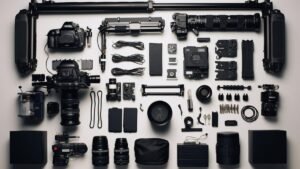Uncategorized
The Journeyman Camera: A Handbook for Selecting the Ideal Instrument
Published
10 months agoon
By
admin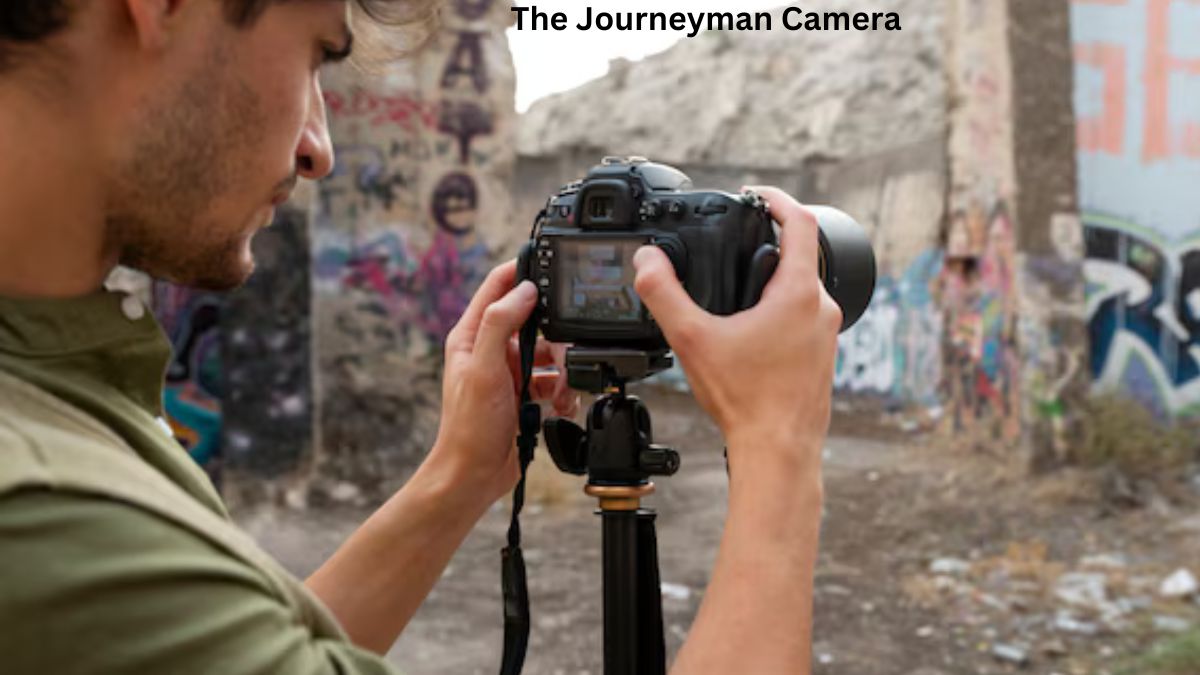
What is the voyage that has the camera drooling?
The Journeyman Camera is more than just a tool for snapping images. It’s an effective tool that has the potential to greatly improve your vacation experiences.
Preserving Memories:
Probably the most obvious justification for traveling with a camera is to record your experiences. Photos serve as visual mementos of your travels, preserving the experiences long after you’ve come home. They might include everything from breathtaking scenery to delectable meals and priceless moments with loved ones.
Sharpening Your Observation:
It makes you more aware of your surroundings to have a camera with you. You will begin to notice details that you might have missed otherwise, such as the beauty of a market’s textures, the expressions on locals’ faces, or the splendor of a dawn.
Building a Visual Narrative:
A collection of images from your journey might create a special narrative. They have the ability to distill the spirit of a location, present the development of your adventure, and produce a visual journal that is a reflection of your own experiences.
Connecting with Others:
Friends and relatives can virtually join you on your vacation when you share your travel images with them. It’s a fantastic way to convey your enthusiasm for novel experiences and pique their interest in travel. Hence, don’t undervalue the potential of a camera, regardless of your level of experience or desire to only record the highlights of your journey. With its help, you may make priceless memories and enhance your journey.
Popular Journeyman Camera Options:
Although the market for cameras is always changing, the following reputable manufacturers and models usually fall into the journeyman category:
Canon: EOS 80D, EOS 90D, EOS 6D Mark II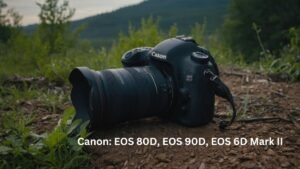
Canon EOS 80D:
A mid-range DSLR camera renowned for its superb image quality and versatility. It has a vari-angle touchscreen LCD, a 24.2-megapixel APS-C CMOS sensor, a DIGIC 6 image processor, a 45-point all cross-type focusing system, and 7 frames per second continuous shooting. It can also record Full HD 1080p video at up to 60 frames per second.
Canon EOS 90D:
An improved model of the EOS 80D, the EOS 90D has a 32.5-megapixel APS-C CMOS sensor with higher resolution, a DIGIC 8 image processor, a 45-point all cross-type autofocus system with Dual Pixel CMOS AF, the ability to record 4K video at up to 30 frames per second, and a vari-angle touchscreen LCD.
Canon EOS 6D Mark II:
A full-frame DSLR with outstanding low-light performance and image quality. It has a full-frame CMOS 26.2-megapixel sensor.
Nikon: D7500, D780, Z5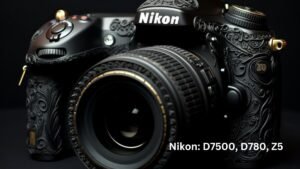
Nikon D7500:
The D7500 is a DSLR camera in the mid-range that is renowned for its sophisticated features and sturdy construction. With a 20.9-megapixel APS-C CMOS sensor, 51-point autofocus system, EXPEED 5 image processor, 8 frames per second continuous shooting, 30 frames per second 4K UHD video recording, and a tilting touchscreen LCD, it has a lot of features.
Nikon D780:
The D780 is a full-frame DSLR camera that combines contemporary photography capabilities with the traditional DSLR handling. A tilting touchscreen LCD, a 51-point autofocus system with Eye-Detection AF, a 24.5-megapixel full-frame CMOS sensor, 7 fps continuous shooting, 4K UHD video recording at up to 30 fps, and an EXPEED 6 image engine are among its features.
Nikon Z5:
Targeting both hobbyists and novices, the Z5 is a mirrorless full-frame camera. It has an EXPEED 6 image processor, a 273-point hybrid autofocus system, a 24.3-megapixel full-frame CMOS sensor, 4.5 frames per second continuous shooting, 30 frames per second 4K UHD video recording, and a tilting touchscreen LCD.
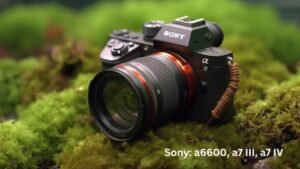 Sony: a6600, a7 III, a7 IV
Sony: a6600, a7 III, a7 IV
Sony A6600:
Designed for pros and hobbyists alike, the a6600 is a top-tier APS-C mirrorless camera. It has a 425-point phase-detection autofocus system, a 24.2-megapixel Exmor CMOS sensor, a BIONZ X image engine, real-time eye focusing and tracking, 11 frames per second continuous shooting, 30 frames per second 4K video recording, in-body image stabilization, and a tilting touchscreen LCD.
Sony A7 III:
The full-frame mirrorless camera, the a7 III is renowned for its exceptional image quality and adaptability. It has a 24.2-megapixel Exmor R CMOS sensor, a BIONZ X image engine, a 693-point phase-detection autofocus system, Real-time Eye AF and Real-time Tracking, a tilting touchscreen LCD, 10 frames per second continuous shooting, 30 frames per second 4K video recording, and in-body image stabilization.
Sony a7 IV:
is a full-frame mirrorless camera with enhanced autofocus capabilities and high definition image capture. Specifics may change depending on when it launches and what it includes, but it should have a better resolution sensor, an enhanced focusing system, better picture processing, 4K video recording, and other improvements over its predecessors.
Fujifilm: X-T30, X-T4, X-S10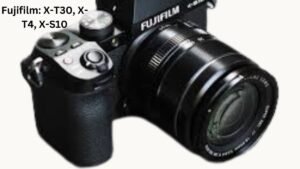
The Fujifilm X-T30:
is a professional and enthusiast-oriented mirrorless camera that is lightweight and compact. It has an X-Trans CMOS 4 26.1-megapixel APS-C sensor and an X-Processor 4 image processor, which work together to produce high-quality photos with superb color and detail reproduction.
With 425 customizable phase-detection autofocus points, this camera boasts superior autofocus capabilities that ensure fast and precise focusing even under difficult shooting settings. Moreover, it has remarkable continuous shooting rates of up to 8 frames per second with a mechanical shutter and 30 frames per second with an electronic one.
Fujifilm X-T4:
Known for its performance and versatility, the X-T4 is a flagship mirrorless camera. With its 26.1-megapixel APS-C X-Trans CMOS 4 sensor and X-engine 4 image engine, it offers exceptional processing speed and image quality.
With 425 phase-detection AF points and enhanced face and eye identification capability, this camera offers excellent autofocus capabilities. Additionally, it has an amazing in-body image stabilization (IBIS) system that offers handheld photography up to 6.5 stops of stabilization.
With its mechanical shutter that allows for 15 frames per second and its electronic shutter that allows for 20 frames per second, the X-T4 is an excellent camera for still images as well as 4K video recording at up to 60 frames per second. Because of its weather-sealed, sturdy design and ergonomic grip and controls, it’s appropriate for professional use.
Fujifilm X-S10:
Designed for both aficionados and novices, the X-S10 is a mirrorless camera that is ergonomic and small. It offers exceptional image quality and performance with its 26.1-megapixel APS-C X-Trans CMOS 4 sensor and X-Processor 4 image processor.
With 425 phase-detection AF points and enhanced face and eye identification capability, this camera offers excellent autofocus capabilities. Moreover, it has a 5-axis in-body image stabilization (IBIS) technology, which offers handheld photography up to six stops of stabilization.
Olympus: OM-D E-M10 Mark IV,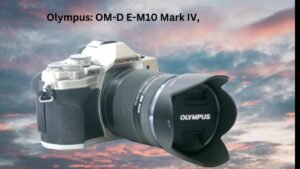
All levels of photographers can use the lightweight, portable Olympus OM-D E-M10 Mark IV mirrorless camera. It has a 20.3-megapixel Micro Four Thirds Live MOS sensor with outstanding detail and a bright color spectrum thanks to the Tropic VIII image processor.
Its 5-axis in-body image stabilization system is one of its standout features; it reduces camera motion and produces crisper images, particularly when using telephoto lenses or in low light. Thanks to its 121 contrast-detection AF points, the camera’s fast and accurate autofocus mechanism allows it to concentrate on moving subjects with ease. It’s therefore appropriate for effortlessly taking still photos and films.
In relation to video, the E-M10 Mark IV allows for flexible composition through up-and-down tilting, and it can capture 4K UHD footage at 30 frames per second.
For those who enjoy photography as much as those who are new to it, the Olympus OM-D E-M10 Mark IV is a highly recommended camera due to its sophisticated capabilities, portability, and remarkable image quality.
In relation to video, the E-M10 Mark IV can record in Full HD 1080p at up to 60 frames per second (fps) and 4K UHD at 30 fps. This enables users to record crisp, detailed, and fluid movements in high-quality video.
OM-D E-M5 Mark III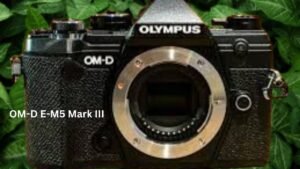
This lightweight, portable mirrorless camera from Olympus, the OM-D E-M5 Mark III, combines cutting-edge imaging technology. Its 20.4-megapixel Micro Four Thirds Live MOS sensor and TruePic VIII image processor enable it to produce high-quality photos with remarkable color accuracy and clarity.
The robust 5-axis in-body image stabilization (IBIS) technology of the E-M5 Mark III is one of its best features; it compensates for camera shake and produces crisper photographs, especially when using telephoto lenses or in low light.
With its 121-point contrast-detection autofocus technology, the camera boasts a rapid and accurate autofocus system that makes it possible to concentrate on moving subjects with ease. This makes it easy to use for taking still photos and videos. Concerning video, the E-M5 Mark III can record in both Full HD 1080p at up to 120 frames per second (fps) for slow-motion effects and 4K UHD at 30 fps. Customers may now record sharp, detailed, and fluid movements in high-quality video.
In general, the Olympus OM-D E-M5 Mark III is a very adaptable and strong camera that provides outstanding image quality, cutting-edge functionality, and mobility, making it a great option for travel, street photography, and other situations.
Panasonic: Lumix G9, Lumix S5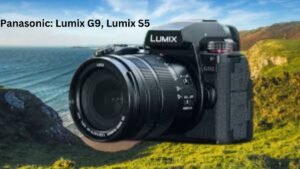
Lumix G9 by Panasonic:
Designed for photographers who need excellent performance, the Lumix G9 is a feature-rich mirrorless camera. It has a 20.3-megapixel Micro Four Thirds sensor, sophisticated Dual Image Stabilization, 225 AF points for quick autofocus, and 60 frames per second 4K video capture. It is appropriate for a variety of shooting situations because to its sturdy construction and simple controls.
Panasonic Lumix S5:
Designed for both photographers and videographers, the Lumix S5 is a small, full-frame mirrorless camera. With 225 AF points, sophisticated focusing, 5-axis sensor-shift stabilization, and 4K video capture at up to 60 frames per second, it has an impressive 24.2-megapixel sensor. It is appropriate for many different shooting situations because of its features that are adaptable and lightweight construction.
Necessary Camera tool kit
Typically, a necessary camera toolkit consists of the following essentials:
Tools for cleaning lenses: For maintaining clean lenses and filters, use a microfiber cloth, lens brush, and cleaning solution.
Additional memory cards can be used to store more pictures and videos.
Extra camera batteries are needed as spares to guarantee continuous filming.
A battery charger is a device used to replenish camera batteries.
Camera strap: A cozy strap to hang the camera on your shoulder or neck.
For steadiness and stable images, particularly in low light or long exposure scenarios, use a tripod or monopod.
A camera bag is a secure way to carry and store your equipment, including lenses and accessories.
These things guarantee that you can keep your equipment in top condition and that you’re ready for any kind of shooting scenario.
Key Characteristics of a Journeyman Camera:
Image Quality:
You can anticipate high-quality images in a range of lighting conditions. Here, factors like sensor size and image processing power are important.
Autofocus:
Capturing crisp photographs requires a dependable and quick autofocus system, particularly in settings with movement.
Features:
Advanced features found on journeyman cameras frequently include manual controls, RAW photography, various shooting modes, and even the ability to record video.
Durability:
These cameras are frequently made with robust construction and weather sealing to endure the demands of frequent use and travel.
Price:
chouse the cameras that provide a strong value proposition, offering high-quality features at an affordable price.
Final Thoughts:
You can most likely rely on your journeyman camera to be a faithful companion for many years to come, helping you create amazing memories while increasing your photographic skills. Though you may eventually upgrade to a more sophisticated camera as your needs and skill set change, the journeyman camera will always be a valuable tool in your toolkit.
A fantastic option for photographers who are ready to take their photography to the next level is a journey camera. This powerful tool offers an excellent balance of features, cost, and functionality, making it an excellent purchase for any aspiring photographer. Enjoy the artistic possibilities and embrace the journey that your new camera will bring!
FAQs
What is a journey camera?
A journey camera is a multipurpose, lightweight camera that appeals to both hobbyists and pros who want to capture memories while traveling.
How does a journey camera differ from traditional cameras?
Journey cameras, in contrast to traditional cameras, place a premium on portability, use, and versatility, which makes them the perfect partners for photographers who appreciate ease of use and flexibility.
What are some key features to look for in a journey camera?
Considerations for important aspects include battery life, connectivity choices, compatibility with accessories, size and weight, image quality, and focusing performance.
Can a journey camera replace a professional DSLR or mirrorless camera?
Even though trip cameras have amazing features, professional-grade cameras could still be necessary for certain types of photography. On the other hand, they make great backup or traveling companions for photographers.
Is investing in a journey camera worth it for beginners?
Indeed, trip cameras are perfect for novices because of their intuitive interface, small size, and adaptability, which make them a great starting point for learning and experimenting with photography.

FAQVehicle.com: Your Trusted Hub for Automotive Answers

Video\&A: Revolutionizing Visual Storytelling in the Digital Age

LoginInsta: Instagram Login Guide, Tips & Troubleshooting

ArchiveBate: Redefining Digital Memory in the Cloud Era

SmoothiePussit: The Delicious Trend Blending Flavor and Wellness

Yin & Yang: The Ancient Symbol of Balance Explained

LeahRoseVIP: Where Luxury Meets Bold Style

Love2Love.lv – Meaningful Matches Online | Your Trusted Dating Platform

Discover Candizi – Flavor-Packed Candy Bliss

Top Stock Picks Daily | 5StarStocks.com Market Insights

LoginInsta: Instagram Login Guide, Tips & Troubleshooting

Video\&A: Revolutionizing Visual Storytelling in the Digital Age

FAQVehicle.com: Your Trusted Hub for Automotive Answers

FAQVehicle.com: Your Trusted Hub for Automotive Answers

Video\&A: Revolutionizing Visual Storytelling in the Digital Age

LoginInsta: Instagram Login Guide, Tips & Troubleshooting

ArchiveBate: Redefining Digital Memory in the Cloud Era

SmoothiePussit: The Delicious Trend Blending Flavor and Wellness

Yin & Yang: The Ancient Symbol of Balance Explained

LeahRoseVIP: Where Luxury Meets Bold Style

Love2Love.lv – Meaningful Matches Online | Your Trusted Dating Platform

Discover Candizi – Flavor-Packed Candy Bliss

Top Stock Picks Daily | 5StarStocks.com Market Insights
Categories
Trending
-

 Uncategorized3 months ago
Uncategorized3 months agoTop 10 Cloud Computing Platforms
-

 Uncategorized7 months ago
Uncategorized7 months agoExploring JUQ-722 Sub Indo: A Detailed Insight into Popular Subtitled Content
-
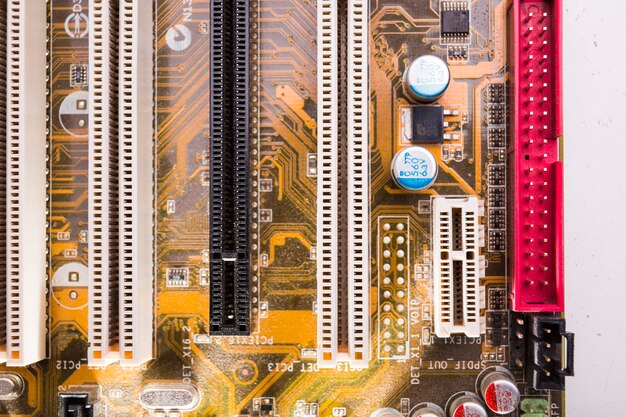
 Uncategorized5 months ago
Uncategorized5 months ago5 Essential BIOS PS2 Configuration Techniques
-

 Uncategorized4 months ago
Uncategorized4 months agoExplore Myfavouriteplaces.org:// Blog for Hidden Travel Gems

